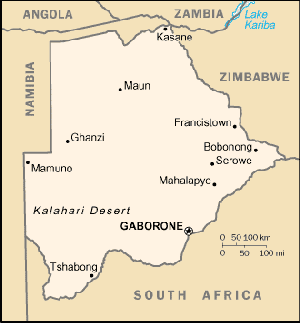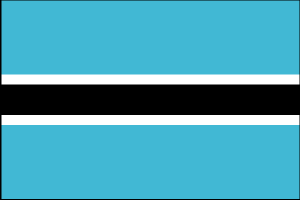
|
Botswana
Background:
Formerly the British protectorate of Bechuanaland, Botswana adopted its new
name upon independence in 1966. The economy, one of the most robust on the
continent, is dominated by diamond mining.
Location:
Location: Southern Africa, north of South Africa
Area: Total: 600,370 sq km, water: 15,000 sq km, land: 585,370 sq km.
Area - comparative: Slightly smaller than Texas
Land boundaries: Total: 4,013 km. border countries: Namibia 1,360 km, South
Africa 1,840 km, Zimbabwe 813 km.
Coastline: 0 km (landlocked)
Climate and Terrain:
Climate: Semiarid; warm winters and hot summers.
Terrain: Predominantly flat to gently rolling tableland; Kalahari Desert in
southwest.
Elevation extremes: Lowest point: junction of the Limpopo and Shashe Rivers 513
m, highest point: Tsodilo Hills 1,489 m.
Natural resources: Diamonds, copper, nickel, salt, soda ash, potash, coal, iron
ore, silver.
Environment - current issues: overgrazing; desertification; limited fresh water
resources
People:
Population: 1,591,232.
Ethnic groups: Tswana (or Setswana) 79%, Kalanga 11%, Basarwa 3%, other,
including Kgalagadi and white 7% .
Religions: Indigenous beliefs 85%, Christian 15%.
Languages: English (official), Setswana.
Government:
Government type: Parliamentary republic.
Capital: Gaborone.
Independence: 30 September 1966 (from UK).
Economy overview:
Botswana has maintained one of the world's highest growth rates since
independence in 1966. Through fiscal discipline and sound management, Botswana
has transformed itself from one of the poorest countries in the world to a
middle-income country with a per capita GDP of $7,800 in 2001. Two major
investment services rank Botswana as the best credit risk in Africa. Diamond
mining has fueled much of expansion and currently accounts for more than
one-third of GDP and for four-fifths of export earnings. Tourism, subsistence
farming, and cattle raising are other key sectors. On the downside, the
government must deal with high rates of unemployment and poverty. Unemployment
officially is 21%, but unofficial estimates place it closer to 40%. HIV/AIDS
infection rates are the highest in the world and threaten Botswana's impressive
economic gains.
GDP - composition by sector: Agriculture: 4%, industry: 44% (including 36%
mining), services: 52%.
Statistics:
Telephones - main lines in use: 150,000.
Telephones - mobile cellular: 200,000.
Radio broadcast stations: AM 8, FM 13, shortwave 4.
Radios: 252,720.
Television broadcast stations: 1.
Televisions: 31,000.
Internet users: 33,000.
Railways: Total: 888 km.
Highways: Total: 10,217 km, paved: 5,620 km. unpaved: 4,597 km.
Airports - with paved runways: 11, with unpaved runways: 81.
Return to Visiting Locations
|

